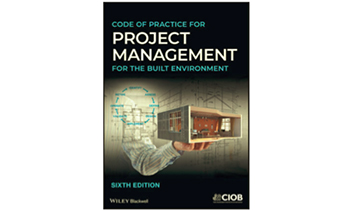Sixth edition of the Code of Practice for Project Management
New edition of the Code of Practice for Project Management for construction professionals.
One of CIOB’s most popular guides, the Code of Practice for Project Management for the Built Environment, has now been updated and a sixth edition published.
The updates are important reflections on how the practice and processes in construction have changed, and the increasing pressures on the industry, with the Code of Practice (CoP) having undergone a significant re-structuring since the 5th edition.
In this new edition, CIOB is aiming to equip construction and project managers with insight into a whole life-cycle approach, where assets can be delivered not only to meet the expected quality, cost and time targets, but where other broader, but equally important, notions of value can be incorporated.
The CoP, in what has been described as a “bold revision” of the previous edition, acknowledges the many challenges in our industry today, and sets the scene in the new version with a set of strategic drivers and some guiding principles:
- Strategic drivers: sustainability, quality, competence and skills, the golden thread of information, delivering ‘value’, the voice of the end-user, driving economic recovery
- Guiding principles: health and safety, EDI (equality, diversity and inclusion), ethics, sustainability, whole-life perspective, project management as a strategic enabler, building information, and leadership
Dr Gina Al-Talal FCIOB, CIOB’s Head of Technical and Standards Development, said: “I am pleased to see this publication undergoing a total revamp at a time when it’s needed more than ever, given the extraordinary pressures on the industry around the world. I have no doubt that this edition will prove an invaluable reference to built environment professionals at all levels. It was not an easy task and my gratitude goes to the construction professionals and academics who contributed so much time and effort into helping us deliver this updated resource.”
The eight themes woven into each chapter help to ensure they are embedded throughout all decision-making processes at every stage of the project: quality, sustainability, value, productivity, leadership, collaboration, knowledge and risk.
Written with built environment practitioners, as well researchers and academics, the new CoP has an easy-to-follow chronological structure, with processes described first in the chapters and guidance notes supporting each section.
The new edition of the Code of Practice for Project Management for the Built Environment starts at £52.99, with a 20% discount for CIOB members. It is available now as an eBook from Wiley, publishers of the CoP, and hard copies will be available in June 2022.
Buy the new Code of Practice at: https://www.wiley.com/en-gb/Code+of+Practice+for+Project+Management+for+the+Built+Environment%2C+6th+Edition-p-9781119715139
Any CIOB members wishing to use the discounted rate can pick up the code from the members portal or can contact lis@ciob.org.uk for more information.
This article first appeared on the CIOB website on May 30, entitled "New edition of the Code of Practice for Project Management for construction professionals out now"
--CIOB
[edit] Related articles on Designing buildings
Featured articles and news
The UK's Modern Industrial Strategy: A 10 year plan
Previous consultation criticism, current key elements and general support with some persisting reservations.
Building Safety Regulator reforms
New roles, new staff and a new fast track service pave the way for a single construction regulator.
Architectural Technologist CPDs and Communications
CIAT CPD… and how you can do it!
Cooling centres and cool spaces
Managing extreme heat in cities by directing the public to places for heat stress relief and water sources.
Winter gardens: A brief history and warm variations
Extending the season with glass in different forms and terms.
Restoring Great Yarmouth's Winter Gardens
Transforming one of the least sustainable constructions imaginable.
Construction Skills Mission Board launch sector drive
Newly formed government and industry collaboration set strategy for recruiting an additional 100,000 construction workers a year.
New Architects Code comes into effect in September 2025
ARB Architects Code of Conduct and Practice available with ongoing consultation regarding guidance.
Welsh Skills Body (Medr) launches ambitious plan
The new skills body brings together funding and regulation of tertiary education and research for the devolved nation.
Paul Gandy FCIOB announced as next CIOB President
Former Tilbury Douglas CEO takes helm.
UK Infrastructure: A 10 Year Strategy. In brief with reactions
With the National Infrastructure and Service Transformation Authority (NISTA).
Ebenezer Howard: inventor of the garden city. Book review.
The Grenfell Tower fire, eight years on
A time to pause and reflect as Dubai tower block fire reported just before anniversary.
Airtightness Topic Guide BSRIA TG 27/2025
Explaining the basics of airtightness, what it is, why it's important, when it's required and how it's carried out.
Construction contract awards hit lowest point of 2025
Plummeting for second consecutive month, intensifying concerns for housing and infrastructure goals.
Understanding Mental Health in the Built Environment 2025
Examining the state of mental health in construction, shedding light on levels of stress, anxiety and depression.























